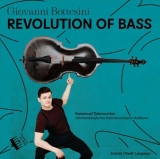In diesem Jahr wird, weitgehend unbeachtet, der 200. Geburtstag des Komponisten Giovanni Bottesini gefeiert. Dieses mangelnde Interesse liegt sicherlich nicht nur an der Pandemie.
Bottesini ist bekannt für seine Kontrabasskompositionen. Dass man den Bass nicht als tumb und grummelnd abtun sollte, beweist Dominik Wagner mit seiner Aufnahme. Neben drei Werken, in denen sich der Bass allein oder in einem Doppelkonzert mit Orchester bewähren darf, bietet die Einspielung auch Kammermusik.
Bottesini darf man als Traditionalisten bezeichnen, da er den Stil der in Italien üblichen Romantik bei seinen Werken einsetzte. Mit 25 Minuten erreicht das 1. Konzert für den Bass ausgewachsene Maße, das sich in der Anlage mit ausgedehntem Kopfsatz, einem feinen Andante und einem furios feurigen Schlusssatz durchaus als Virtuosenkonzert sehen lässt. Die Doppelkonzerte, eines mit Geige und eines auf Themen aus Bellinis I Puritani mit dem Cello bieten noch mehr am sängerischen Ideal des Belcanto orientierte Melodik und einen sinnlichen, auf Publikumswirksamkeit bedachten Umgang mit Rhythmik und Agogik.
Die Kammermusik wird durch zwei Duowerke mit Klavier sowie zwei weitere Werken, bei denen sich als dritte Stimme ein Sopran dazugesellt, vertreten. Sie zeigen, dass Bottesini situationsbezogen komponierte, um sein Instrument einsetzen zu können. Die Singstimme bildet zugleich die Brücke zum Kontrabass, dem Dominik Wagner mit seinem Spiel ebenfalls singende Qualitäten, die er mit der Stimme Pavarottis vergleicht, geben will.
Wagner beherrscht fürwahr sein Instrument und neben der technisch lockeren Bewältigung der Finessen der Kompositionen kann er diesem äußerlich tumben Klotz von Instrument nicht nur leichte und schwebende Töne erzeugen, sondern auch die Nähe des Klanges zur tiefen menschlichen Stimme hörbar gestalten.
Bei seiner Expedition zu Bottesini erfährt er prominente Unterstützung. Der Geiger Benjamin Schmid, der Cellist Jeremias Fliedl, die Sopranistin Ursula Langmayr und schließlich der ICMA-Preisträger Can Cakmur beleben nicht nur die Aufnahme mit ihren Soli, sondern geben mit ihrem ausgefeilten Spiel bzw. Gesang noch zusätzliche Impulse, um Bottesini und den Kontrabass ins rechte Licht zu rücken. Das Württembergische Kammerorchester Heilbronn unter Emmanuel Tjeknavorian ist ein aufmerksamer Partner, der dem Solisten vornehm den Vortritt lässt und das Panorama belebt.
Dem Label ist ein Fehler unterlaufen, da es die Spielzeit der CD mit einer Stunde angibt, die aber tatsächlich zehn Minuten mehr zu bieten hat.
This year the music world celebrates the largely unnoticed 200th birthday of the composer Giovanni Bottesini. This lack of interest is certainly not only due to the pandemic.
Bottesini is known for his double bass compositions. Dominik Wagner’s recording proves that the bass should not be dismissed as dull and grumbling. In addition to three works in which the bass may prove itself alone or in a double concerto with orchestra, the recording also offers chamber music.
Bottesini may be called a traditionalist, since he employed the style of Romanticism, common in Italy, in his works. At 25 minutes, the 1st Concerto for Bass reaches full-grown dimensions, and in its layout, with an extended opening movement, a fine Andante, and a furiously fiery final movement, it can certainly be seen as a virtuoso concerto. The double concertos, one with violin and one on themes from Bellini’s I Puritani with cello, offer even more melodicism oriented to the vocal ideal of bel canto and a sensual treatment of rhythm and agogic, aimed at audience appeal.
Chamber music is represented by two duo works with piano as well as two other works in which a soprano joins as a third voice. They show that Bottesini composed situationally in order to be able to use his instrument. At the same time, the singing voice forms the bridge to the double bass, which Dominik Wagner also wants to give singing qualities with his playing, which he compares to Pavarotti’s voice.
Wagner is truly in command of his instrument, and in addition to mastering the finesses of the compositions in a technically relaxed manner, he is not only able to produce light and floating tones on this outwardly dull lump of an instrument, but also to make the closeness of the sound to the deep human voice audible.
In his expedition to Bottesini he receives prominent support. Violinist Benjamin Schmid, cellist Jeremias Fliedl, soprano Ursula Langmayr and finally ICMA prize winner Can Cakmur not only enliven the recording with their solos, but also provide additional impetus with their polished playing or singing to put Bottesini and the double bass in perspective. The Württemberg Chamber Orchestra Heilbronn under Emmanuel Tjeknavorian is an attentive partner, nobly letting the soloist take the lead and enlivening the panorama.
The label has made a mistake in stating the playing time of the CD as one hour, but it actually has ten minutes more to offer.
























